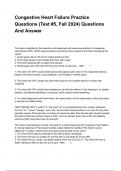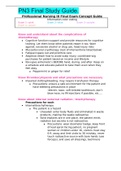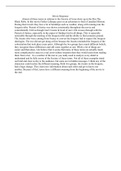Congestive Heart Failure Practice
Questions (Test #5, Fall 2024) Questions
And Answer
The client is admitted to the telemetry unit diagnosed with acute exacerbation of congestive
heart failure (CHF). Which signs/symptoms would the nurse expect to find when assessing this
client?
1. Apical pulse rate of 110 and 4+ pitting edema of feet.
2. Thick white sputum and crackles that clear with cough.
3. The client sleeping with no pillow and eupnea.
4. Radial pulse rate of 90 and CRT less than three (3) seconds. - ANS 1
1. The client with CHF would exhibit tachycardia (apical pulse rate of 110), dependent edema,
fatigue, third heart sounds, lung congestion, and change in mental status.
2. The client with CHF usually has pink frothy sputum and crackles that do not clear with
coughing.
3. The client with CHF would report sleeping on at least two pillows, if not sleeping in an upright
position, and labored breathing, not eupnea, which means normal breathing.
4. In a client diagnosed with heart failure, the apical pulse, not the radial pulse, is the best place
to assess the cardiac status.
TEST-TAKING HINT: In option "3," the word "no" is an absolute term and, usually, absolutes,
such as "no," "never," "always," and "only," are incorrect because there is no room for any other
possible answer. If the test taker is looking for abnormal data, then the test taker should exclude
the options that have normal values in them, such as eupnea, pulse rate of 90, and capillary
refill time (CRT) less than three (3) seconds.
The nurse is developing a nursing care plan for a client diagnosed with congestive heart failure.
A nursing diagnosis of "decreased cardiac output related to inability of the heart to pump
effectively" is written. Which short-term goal would be best for the client?
1. The client will be able to ambulate in the hall by date of discharge.
2. The client will have an audible S1 and S2 with no S3 heard by end of shift.
3. The client will turn, cough, and deep breathe every two (2) hours. 4. The client will have a
SaO2 reading of 98% by day two (2) of care - ANS 2
,1. Ambulating in the hall by day of discharge would be a more appropriate goal for an
activity-intolerance nursing diagnosis.
2. Audible S1 and S2 sounds are normal for a heart with adequate output. An audible S3 sound
might indicate left ventricular failure, which could be life threatening.
3. This is a nursing intervention, not a short-term goal, for this client.
4. A pulse oximeter reading would be a goal for impaired gas exchange, not for cardiac output.
TEST-TAKING HINT: When reading a nursing diagnosis or problem, the test taker must be sure
that the answer selected addresses the problem. An answer option may be appropriate care for
the disease process but may not fit with the problem or etiology. Remember, when given an
etiology in a nursing diagnosis, the answer will be doing something about the problem (etiology).
In this question the test taker should look for an answer that addresses the ability of the heart to
pump blood.
The nurse is developing a discharge-teaching plan for the client diagnosed with congestive
heart failure. Which interventions should be included in the plan? Select all that apply.
1. Notify the health-care provider of a weight gain of more than one (1) pound in a week.
2. Teach the client how to count the radial pulse when taking digoxin, a cardiac glycoside.
3. Instruct the client to remove the saltshaker from the dinner table.
4. Encourage the client to monitor urine output for change in color to become dark.
5. Discuss the importance of taking the loop diuretic furosemide at bedtime. - ANS 2,3
1. The client should notify the HCP of weight gain of more than two (2) or three (3) pounds in
one (1) day.
2. The client should not take digoxin if the radial pulse is less than 60.
3. The client should be on a low-sodium diet to prevent water retention.
4. The color of the urine should not change to a dark color; if anything, it might become lighter
and the amount will increase with diuretics.
5. Instruct the client to take the diuretic in the morning to prevent nocturia.
TEST-TAKING HINT: This is an alternative-type question—in this case, "Select all that apply." If
the test taker missed this statement, it is possible to jump at the first correct answer. This is one
reason that it is imperative to read all options before deciding on the correct one(s). This could
be a clue to reread the question for clarity. Another hint that this is an alternative question is the
number of options. The other questions have four potential answers; this one has five. Numbers
, in an answer option are always important. Is one (1) pound enough to indicate a problem that
should be brought to the attention of the health-care provider?
The nurse enters the room of the client diagnosed with congestive heart failure. The client is
lying in bed gasping for breath, is cool and clammy, and has buccal cyanosis. Which
intervention would the nurse implement first?
1. Sponge the client's forehead.
2. Obtain a pulse oximetry reading.
3. Take the client's vital signs.
4. Assist the client to a sitting position - ANS 4
1. Sponging dry the client's forehead would be appropriate, but it is not the first intervention.
2. Obtaining a pulse oximeter reading would be appropriate, but it is not the first intervention.
3. Taking the vital signs would be appropriate, but it is not the first intervention.
4. The nurse must first put the client in a sitting position to decrease the workload of the heart by
decreasing venous return and maximizing lung expansion. Then, the nurse could take vital
signs and check the pulse oximeter and then sponge the client's forehead.
TEST-TAKING HINT: In a question that asks the nurse to set priorities, all the answer options
can be appropriate actions by the nurse for a given situation. The test taker should apply some
guidelines or principles, such as Maslow's hierarchy, to determine what will give the client the
most immediate assistance.
The nurse is assessing the client diagnosed with congestive heart failure. Which
signs/symptoms would indicate that the medical treatment has been effective?
1. The client's peripheral pitting edema has gone from 3+ to 4+.
2. The client is able to take the radial pulse accurately.
3. The client is able to perform ADLs without dyspnea.
4. The client has minimal jugular vein distention. - ANS 3
1. Pitting edema changing from 3+ to 4+ indicates a worsening of the CHF.
2. The client's ability to take the radial pulse would evaluate teaching, not medical treatment.
3. Being able to perform activities of daily living (ADLs) without shortness of breath (dyspnea)
would indicate the client's condition is improving. The client's heart is a more effective pump and
can oxygenate the body better without increasing fluid in the lungs.
4. Any jugular vein distention indicates that the right side of the heart is failing, which would not
indicate effective medical treatment.






